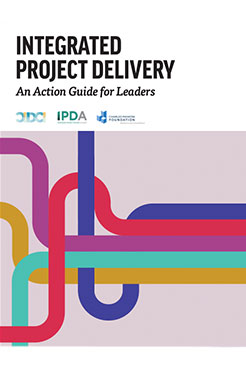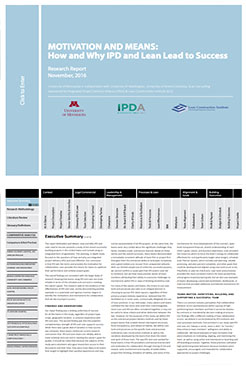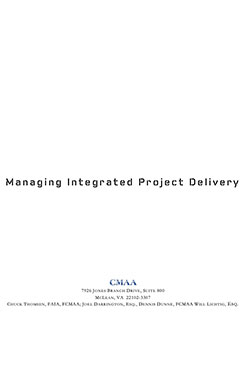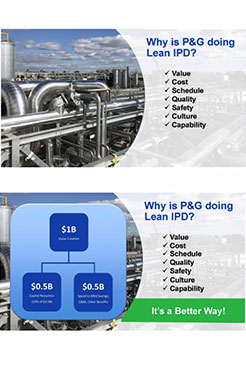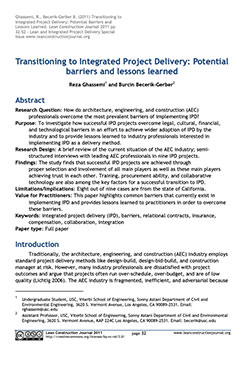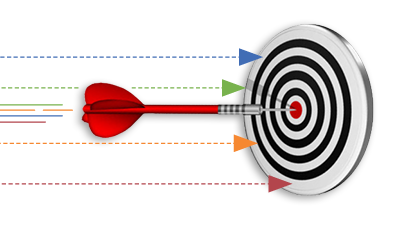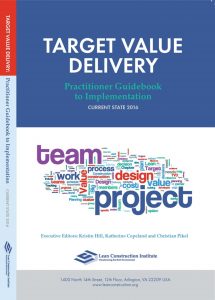Integrated Project Delivery (IPD)
An Introduction to Integrated Project Delivery
Integrated Project Delivery (IPD) is an important pillar of the Lean Construction Institute. The construction industry has seen a sharp decline in productivity and project outcomes since the late 1960s. A large reason for this decline is that a vast majority of projects are delivered late and over-budget.
The aim of IPD is to create a better system of collaboration and communication between the various parties involved in a construction project, from the owner to the designer to the builder and any trades and suppliers involved. This method stands in contrast to the traditional design-bid-build project delivery model in which the owner of the project has separate contracts with each party and serves as a go-between for the design and build teams.
What is IPD?
IPD in Lean construction and design stands for Integrated Project Delivery. IPD is a construction project delivery method by which key parties involved in the design, fabrication, and construction aspects of a project are joined together under a single agreement. This allows for ongoing communication and collaboration throughout the project’s phases which decreases waste while increasing efficiency, respect for team members, and project outcomes including profits.
What are the Benefits of IPD?
By aligning the various parties involved in the project and ensuring they stay in continuous communication throughout, IPD drastically increases efficiency and eliminates waste in projects. In this case, “waste” refers to both literal material waste and intangible waste such as wait times, poorly assigned personnel, and overproduction.
Involving the design and construction team members collaboratively throughout the delivery process decreases communication-related issues. For example, in a design-bid-build structure, you might find that the builders end up confused by a design concept or see it as unworkable. If an issue like that is addressed during the design stage, you remove the waste of time and associated costs in fixing that kind of a problem and increase your project’s efficiency in your effort to deliver it on time.
IPD Methods
The IPD method is often consummated through a single physical contract between the involved parties of the construction project. The contract outlines expectations for each group and clearly states the shared goals for the project. Below we explore several types of IPD contracts and agreements which fuel LCI’s mission of integrating project delivery.
Multi-Party Agreements
A multi-party agreement is a type of agreement in which the key parties of the project team join together in a shared contract. In some cases, only three parties (owner, designer, construction manager) will sign the main agreement, making it a tri-party agreement. Any contract that contains more than three main signers becomes a multi-party agreement. The agreement promises continual involvement for all parties throughout the project.
Unlike design-bid-build or design-build contracts, multi-party agreements consist of a single document signed by each involved party in the project. Sometimes multi-party agreements can contain more than a dozen main signatories including mechanical contractors, framing contractors, and the like. There may also be sub-signatories signed underneath the main parties, allowing the contract to branch out depending on the needs of the main signatories.
Relational Contracting
A relational contract is an agreement that governs a long-term relational commitment between two or more parties. In the design and construction industry, relational contract defines the ongoing terms of a working relationship. As the relationship strengthens between those involved, the contract becomes more efficient as the parties involved in the pact trust one another.
Relational contracts are the types of agreements that parties involved in an IPD team sign into. This is because there is inherent trust that the other teams on the contract will complete their work as efficiently as possible in order to maximize profit for all.
The terms of the contract list out the expectations of the various groups and how their involvement will intersect with one another over time. For instance, if the construction team is needed in the design stage of the process, their responsibilities during that time would be listed out in the contract.
Integrated Forms of Agreement (IFOAs)
An Integrated Form of Agreement – also sometimes called an IPD Contract – is a common type of relational contract used in Integrated Project Delivery. This legal document mandates that the parties must truly collaborate on the project rather than just having orders come from the top-down.
What is an IFOA Contract?
An IFOA is the physical joint contract signed by the various groups of a construction project. The deal forces the groups to work together as it legally binds them to share risks and financial rewards from the project.
How Do IFOAs Generate Value?
If a project operating under an IFOA is delivered under budget, all signed parties split the savings in addition to their profits (parties will split the savings as agreed to at the beginning of the project regardless of the specific degree to which each individual party went under or over budget during the project’s design and construction).
As a relational agreement, the benefit of an IFOA is that it clearly states in written language the expectations for each party. The total cost of work, estimated profit, and contingency are all baked into the shared contract value before the project starts. This means that all parties operating under the contract understand what financial targets need to be hit in order to come away with all or some of their profit.
On the other hand, if something goes wrong, the presence of the contract removes any potential conflicts over whose fault it is, seeing as all parties share equal profit risk by joining together on the accord. A foundation of trust between the groups involved in the project is crucial for a successful IPD plan.
IPD In the Real World
Owners, builders, and designers all over the world have drastically improved project outcomes through IPD. The Rocky Mountain Institute utilized IPD in the construction of a net-zero energy building and had tremendous results.
How to Adopt IPD
Set Targets
Define the project owner’s business case and goals. Determine your budget and work to eliminate unknowns and variables as much as possible. The fewer unknown costs you are accounting for, the better equipped you will be to handle any curveballs thrown at your team.
Build the team
Use a best value selection process to contract key stakeholders prior to or during concept design to validate targets and unify the team. Make sure your team is on board with using an IPD model and is prepared to take the necessary steps to implement it.
Learn as a team
Provide ongoing training and coaching for the team to increase adoption of Lean methods. A major facet of the IPD method is a willingness to innovate and to let the expertise of your team members shine. Provide space for those people to emerge as leaders in your project.
Support the team
Contracts should support (not thwart) a good team culture and adoption of Lean methods. A rising tide lifts all boats, so encourage other members and teams in the project to be unafraid to seek help and to constantly communicate.
Enlist Help
At LCI, our mission is to provide value to the entirety of the design and construction industry by providing resources to guide, implementation of IPD practices. Get started with Lean today to receive the knowledge and tools needed to improve your project.
Requirements for a Successful IPD Project
IPD might not be the right method for every project. Project size and project status are factors to consider when utilizing IPD. Similarly, a team with fewer resources may not have the ability to educate those who have not built using IPD in the past. Here are some other requirements for a successful IPD campaign.
- An owner willing to remain engaged and collaborative
- Trust for all parties
- Complete buy-in from all involved
- A desire to innovate
- A value-driven mentality
- The resources to continuously educate team members on IPD processes
Pros
- Promotes innovation by involving all members of the project throughout.
- Decreases the number of change orders issued – meaning fewer project expenses.
- Eliminates waste in materials and intangible forms (wait times, overproduction, etc.)
- Removes the owner serving as a go-between for communication between design & construction teams.
- Ensures everyone benefits financially if the project is a success.
Cons
- Requires time and resources to educate the team on Lean and drive the implementation.
- Requires that the team focus on building and maintaining an environment of trust.
- Requires that leaders lead and move from traditional management behaviors.
- Requires that the owner be actively involved.
IPD Contracts
The Lean Construction Institute is committed to transforming the design and construction industry by providing educational resources, conducting surveys and research, and facilitating local and national Lean events. It is only through the power of the LCI Corporate Members that LCI is able to offer the supplementary resources below. Explore Partner Programs to learn about how ConsesusDocs helps with IPD contracts.
Lean Assessments
How strong is your Lean knowledge? Take a Lean assessment to determine your current state so you have a baseline for improvement. Lean assessments are available for individuals, teams, and organizations alike. Whether you’re new to Lean or are an experienced Lean practitioner, Lean assessments are a great way to get started at LCI!
TAKE ASSESSMENTMore Lean Topics
From 5s to 5 Why, explore popular Lean design and construction topics below.

